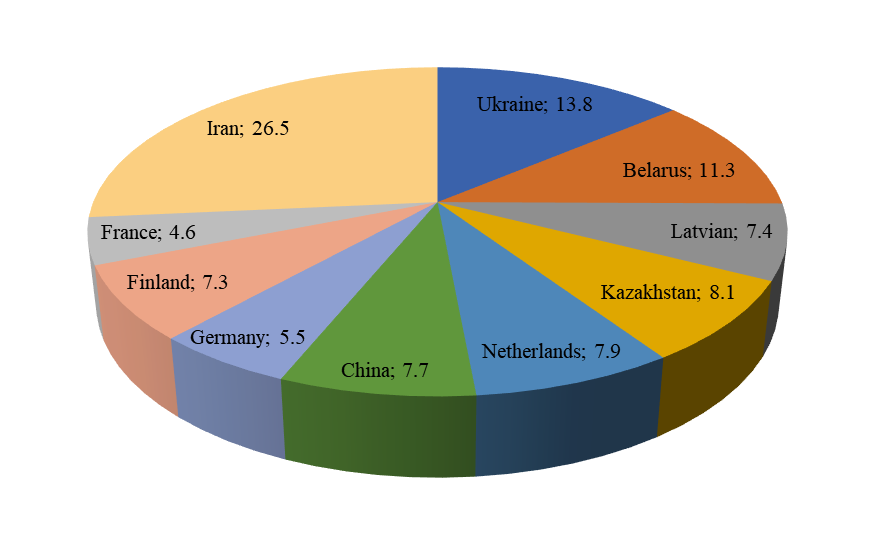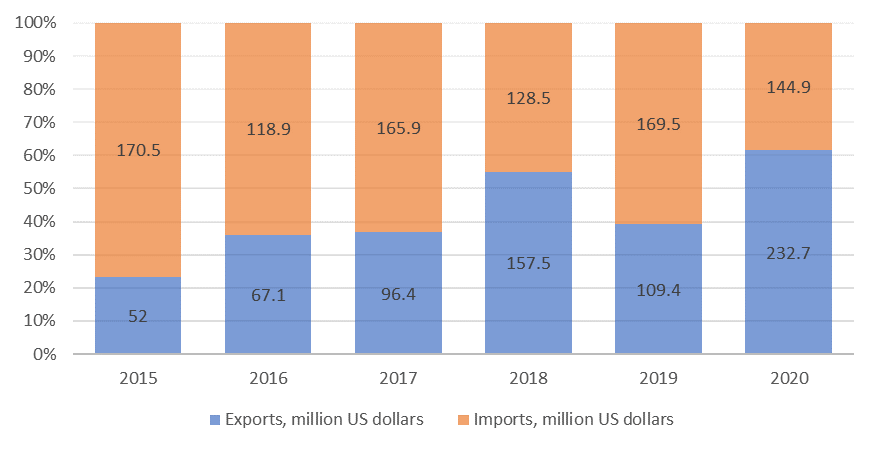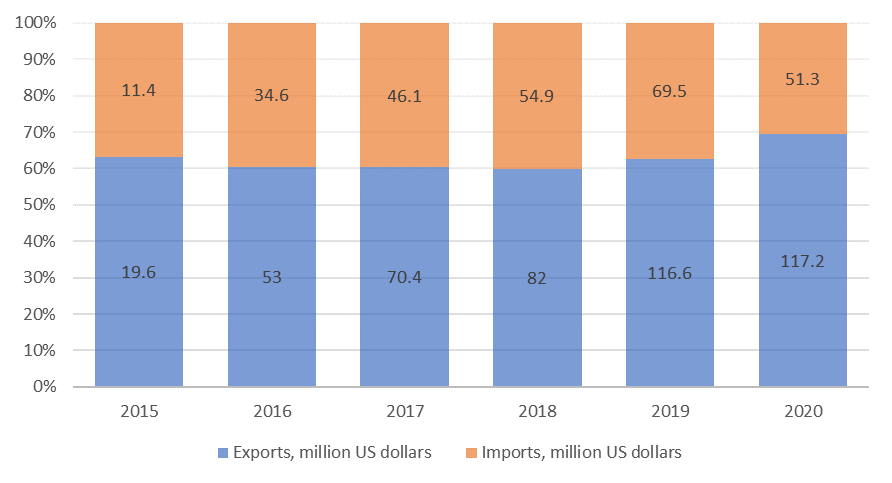Abstract
The article analyses the impact of the development of domestic and foreign trade on the degree of the socio-economic well-being and the level of development of rural areas from the standpoint of sustainability. Considering the impact of domestic and foreign trade on the socio-economic development of the country as a whole and on individual regions, the article emphasizes its role as a structure-forming and accelerating factor. The role of domestic and foreign trade in the balance of the domestic market is great due to the import of mass-demand goods, as well as reducing unemployment due to the expansion of employment in the field of exchange. Export production contributes to the utilization of production capacities and the preservation of jobs. The main factors of dependence of the trade results at all levels with the filling of the regional budget and the well-being of the citizens living in it are noted. All foreign trade is divided into two large groups of trading partners, namely the countries of the CIS member states and the non-CIS countries. The authors identified the 10 top trade partners of the Tambov Region, the list of which is constantly changing depending on the private state of affairs in the country and the global market situation as a whole. The article provides a rough estimation of the trade turnover of the Tambov region for a certain time, depending on a variety of factors.
Keywords: Export-import relations, sustainable development, trade turnover
Introduction
Historically, natural diversity has created both advantages and disadvantages for each rural area, which are expressed in the overproduction of some goods and the deficiency of others. The most effective mechanism for regulating this problem is trade. If the global exchange of goods is not able to completely solve this problem, it can significantly reduce the negative effects (Bavorová et al., 2021; Lipatova et al., 2021).
Trade, both external and internal, is one of the key features that can influence the formation of a favourable environment for the sustainable socio-economic development of rural areas (Zhidkov & Voronina, 2019). This is because trade makes it possible to realize the surplus produced in the analysed rural area and meet the need for goods that are not produced in this area.
Problem Statement
As a result of the introduction of quarantine by various countries, there was a break in the foreign trade chains between the partners. At the same time, the producers faced unilateral refusals of foreign partners to sign contracts, irregular deliveries of imported raw materials and materials due to border closures, the cancellation of cargo transportation, a significant increase in transport prices, as well as the cancellation of planned events that allow international exporters to present their products, find new partners and cover export contracts.
President Vladimir Putin has repeatedly spoken about the possibility of organizing favourable situations for export-oriented companies. Therefore, an increase in the export of non-energy grade-out goods and an increase in the export of agricultural and manufacturing products are determined as a key goal of the national project "International Cooperation and Export", which is being implemented in Russia. The national project should double non-resource exports to 250 billion US dollars by 2024, and increase exports of services to 100 billion US dollars.
Research Questions
The article examines the impact of world trade on the socio-economic development of rural areas in the region. In particular:
- the analysis of foreign trade turnover with the countries of the near and far abroad is carried out,
- the factors of progressive sustainable socio-economic growth are considered.
Purpose of the Study
The study is aimed to consider the dependence of the growth of world trade on the sustainable development of rural areas of the Tambov region.
Research Methods
The research methods included monographic, statistical, economic, abstract-logical, and others.
Findings
Over the past few years, the administration of the Tambov region has made various attempts to promote regional products to world markets. These actions should stimulate local production, create new jobs and increase the level of well-being of citizens.
According to the available information in the trade sphere, the Tambov region has achieved serious results, for example, in 2019 the region's turnover in foreign trade amounted to about 465 million US dollars, which is 10% more than in 2018, as a result, the first half of the year exceeded the same period of 2019. Exports of products in the first half of 2020 increased by 2.2 times, and the growth of external trade turnover was 148%. By the end of 2019, the trade turnover amounted to $ 465.1 million, and the export of products – $ 226.1 million. In 2020, according to the results of six months, the trade turnover amounted to 314.0 million dollars, and exports – by 212.6 million dollars (Grekova, 2020).
According to the employees of the Department of Regional Development and Investment Support of the Tambov region, a significant increase in the price volumes of exports occurred due to an increase in the volume of export supplies for the commodity group "Food products and raw materials" – by 122.1 million US dollars. According to customs statistics, Tambov enterprises now conduct foreign trade with 81 countries of the world (Grekova, 2020).
The number of countries with which the Tambov Region has established strong trade relations is constantly growing. In 2020, seven more countries were added to the number of trade partners, and as a result, the region traded with 81 countries of the world, this indicator indicates the demand for products produced in the Tambov region and the growing interest in further trade cooperation.
According to the results of 2020, the Tambov region entered the top three of the Central Federal District in terms of export growth dynamics, but it is premature to make a forecast in the current situation because the time is now turbulent, and it is almost impossible to predict what will happen tomorrow.
The countries with the highest trade turnover for 2020 are shown in Figure 01. They account for three-quarters of the total volume of trade. Over the past year, the export of goods increased by 2.2 times. Among the factors that influenced the increase in the value of exports, we can distinguish such as an increase in the export of Russian goods to several countries, including the Republic of Belarus by 1.7 times, Ukraine by 1.9 times and Kazakhstan.

The main exports of the Tambov region are still food products and raw materials, which account for slightly less than 85% of the total volume of exported goods. Unfortunately, this narrow specialization can become one of the risk factors that have adverse consequences for the entire region (Grekova, 2017; Haji, 2021; Rudoy et al., 2019).
The structure of the Tambov region's import is represented by four main categories, among which machinery equipment and vehicles predominate 29.1%, metals and products 23.2%, raw materials and food products - 22.5%, rubber and chemical products - 20% (Levushkina et al., 2021).
According to the results of 2020, the Tambov region takes 58th place in terms of exports in Russia, over the past few years this result has increased by 10 positions. The main increase in the share of exports is accounted for by non-resource products. The administration of the Tambov region undertakes a variety of measures to increase the export volumes of non-resource goods. One of the key tasks of the regional administration is to support entrepreneurs who aim at international markets. In connection with the pandemic, the enterprises related to the field of IT activity have every chance to make a powerful leap to ensure their own and public well-being.
Foreign trade of the Tambov Region in 2020, with Non-CIS Countries, ended with a positive balance of USD 87.8 million (Figure 02). This indicates the demand and good quality of the products manufactured at the enterprises of the Tambov region (Grekova, 2020).
According to the results of 2020, foreign trade with the CIS member states is characterized by a positive balance of USD 65.9 million (Figure 03).
The positive balance of foreign trade relations indicates the effective socio-economic development of rural areas. The increase in the scale of trade is caused by an increase in the cost of manufactured goods and an increase in the export volume of products (Grekova, 2017).


The rate of increase in the volume of output indicates the presence in the Tambov region of factors for progressive sustainable socio-economic growth, which is based on the development of the agro-industrial complex of the region, the growth of the general well-being of the population of the region and, as a result, the level of their education, technical skills and demand as specialists. The widespread introduction of new technologies in all branches of production and spheres of life will provide the Tambov Region with a favourable vector for many years.
Conclusion
At the same time, it is worth remembering that the interaction between the agro-industrial complex and other sectors of economics is formed at different levels and stages of development. This factor works extremely effectively in the absence of a developed economic system, in proportion to its development, the variety of mutually beneficial socio-economic ties increases, and over time, the role of the agro-industrial complex as the central link of economic growth weakens and dies away.
Based on the above, the further processes will be mirrored: the insignificant consumer demand with a slight and extremely long-term increase in income in the agro-industrial complex, the limited needs for agricultural production resources, the narrowly focused demand in the agricultural processing sector and stagnant wages (Grekova, 2017).
In the Tambov region due to numerous programs to support the agro-industrial complex and sustainable development of rural areas many positive results were achieved in 2020:
- meat and grain exports were doubled;
- more than 500 thousand tons of livestock and poultry meat were produced;
- pork production increased by a quarter;
- egg production increased by 21% ;
- production of milk, cheese, and wheat flour increased by 10%;
- food production increased by 15%.
The achieving of such indicators is a clear result of a purposeful and systematic policy aimed at sustainable socio-economic development of the agro-industrial complex in particular and rural areas in general. However, this is only a step towards implementing a modern, effective mechanism for managing the country's agro-industrial complex.
References
Bavorová, M., Bednarikova, Z., Ponkina, E. V., & Visser, O. (2021). Agribusiness social responsibility in emerging economies: Effects of legal structure, economic performance and managers’ motivations. Journal of Cleaner Production, 289, 125157.
Grekova, N. S. (2020). Promising directions of socio-economic development of rural areas. In the collection: Priority directions of regional development. Materials of the All-Russian (national) scientific and practical conference with international participation, 59-63.
Grekova, N. S. (2017). Risk management in agriculture. Theory and practice of world science, 7, 7-9.
Haji, K. (2021). E-commerce development in rural and remote areas of BRICS countries. Journal of Integrative Agriculture, 20(4), 979-997.
Levushkina, S. V., Lisova, O. M., Svistunova, I. G., & Shutova, O. A. (2021). State and prospects of providing Russian rural areas with engineering life support systems. IOP Conference Series: Earth and Environmental Science, 745(1), 012022.
Lipatova, N. N., Mamai, O. V., Mamai, I. N., Gazizyanova, Y. Y., & Galenko, N. N. (2021). Agricultural cooperation as a factor in sustainable rural development. IOP Conference Series: Earth and Environmental Science, 745(1), 012018.
Rudoy, E., Petukhova, M., & Ryumkin, S. (2019). Key challenges and opportunities of scientific and technological development of Russia's crop industry. IOP Conference Series: Earth and Environmental Science, 274(1), 012071.
Zhidkov, S. A., & Voronina, E. A. (2019). Situation and prospects of development of the world market of food grain. Bulletin of the Michurinsk State Agrarian University, 1, 154-156.
Copyright information

This work is licensed under a Creative Commons Attribution-NonCommercial-NoDerivatives 4.0 International License.
About this article
Publication Date
01 February 2022
Article Doi
eBook ISBN
978-1-80296-123-2
Publisher
European Publisher
Volume
124
Print ISBN (optional)
-
Edition Number
1st Edition
Pages
1-886
Subjects
Land economy, land planning, rural development, resource management, real estates, agricultural policies
Cite this article as:
Grekov, A. N., Grekova, N. S., & Goncharova, N. A. (2022). World Trade And Its Impact On The Socio-Economic Development Of Rural Areas. In D. S. Nardin, O. V. Stepanova, & E. V. Demchuk (Eds.), Land Economy and Rural Studies Essentials, vol 124. European Proceedings of Social and Behavioural Sciences (pp. 356-361). European Publisher. https://doi.org/10.15405/epsbs.2022.02.45

